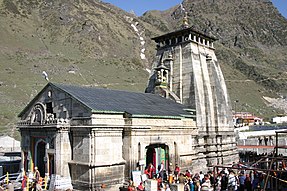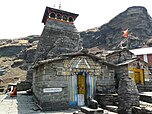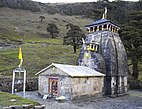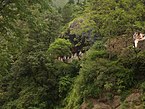Kalpeshwar
| Kalpeshwar Temple | |
|---|---|
Pandavas (according to legend) | |
| Completed | Unknown |
Kalpeshwar (
Legend
A folk legend about Panch Kedar relates to the
Not finding Shiva in Varanasi, the Pandavas went to
A variant of the tale credits Bhima of not only catching the bull, but also stopping it from disappearing. Consequently, the bull was torn asunder into five parts and appeared at five locations in the Kedar Khand of Garhwal region of the Himalayas.[4]
After completing the pilgrimage of Shiva's
- Worship
The temple priests at this temple also are the Dasnamis and Gossains, disciples of
Geography


The Kalpeshwar temple is located in the Urgam valley of the Himalayan mountain range near Urgam village (2 km (1.2 mi) short of the temple). On the bridle path from Helang to Kalpeshwar, the confluence of the Alaknanda and Kalpganga rivers is seen. Kalpganga river flows through the Urgam valley.[8][9] The Urgam valley is a dense forest area. The valley has apple orchards and terraced fields where potato is grown extensively.[10]
Access
Access to Kalpeshwar by road up to Urgam is from Rishikesh, a distance of 253 km (157.2 mi) on the Rishikesh-Badrinath road. The road is very rough and not suitable to normal cars, and should only be driven by skilled drivers. The nearest airport is at Jolly Grant, Dehradun, 272 km (169.0 mi) away and the nearest railhead, Rishikesh, is 255 km (158.4 mi) away.
Boodha Kedar temple surrounded by potato fields is seen on the trek route. Also seen is the Dhyan Badri temple at Urgam Village, one of the Sapt Badri (seven Badri) temples.[11]
References
- ^ a b "Kalpeshwar". Shri Badrinath -Shri Kedarnath Temple Committee. Archived from the original on 21 July 2011. Retrieved 17 July 2009.
- )
- ^ "Kalpeshwar: Panch Kedar- Travel Guide". chardhamyatra.org. Archived from the original on 12 February 2009. Retrieved 17 July 2009.
- ^ a b "Panch Kedar Yatra". Archived from the original on 24 May 2011. Retrieved 5 July 2009.
- ISBN 9788185880167.
- ^ "Panch Kedar". Archived from the original on 31 August 2009. Retrieved 15 July 2009.
- ISBN 978-81-7533-081-8.
- ^ "Sight seeing and Things to do in Kalpeshwar". Archived from the original on 20 June 2009. Retrieved 17 July 2009.
- ^ "Kalpeshwar". Archived from the original on 13 August 2007. Retrieved 17 July 2009.
- ^ "Trekking in India". Archived from the original on 2 May 2013. Retrieved 12 July 2009.
- ^ "Kalpeshwar temple". Archived from the original on 8 October 2011. Retrieved 17 July 2009.






